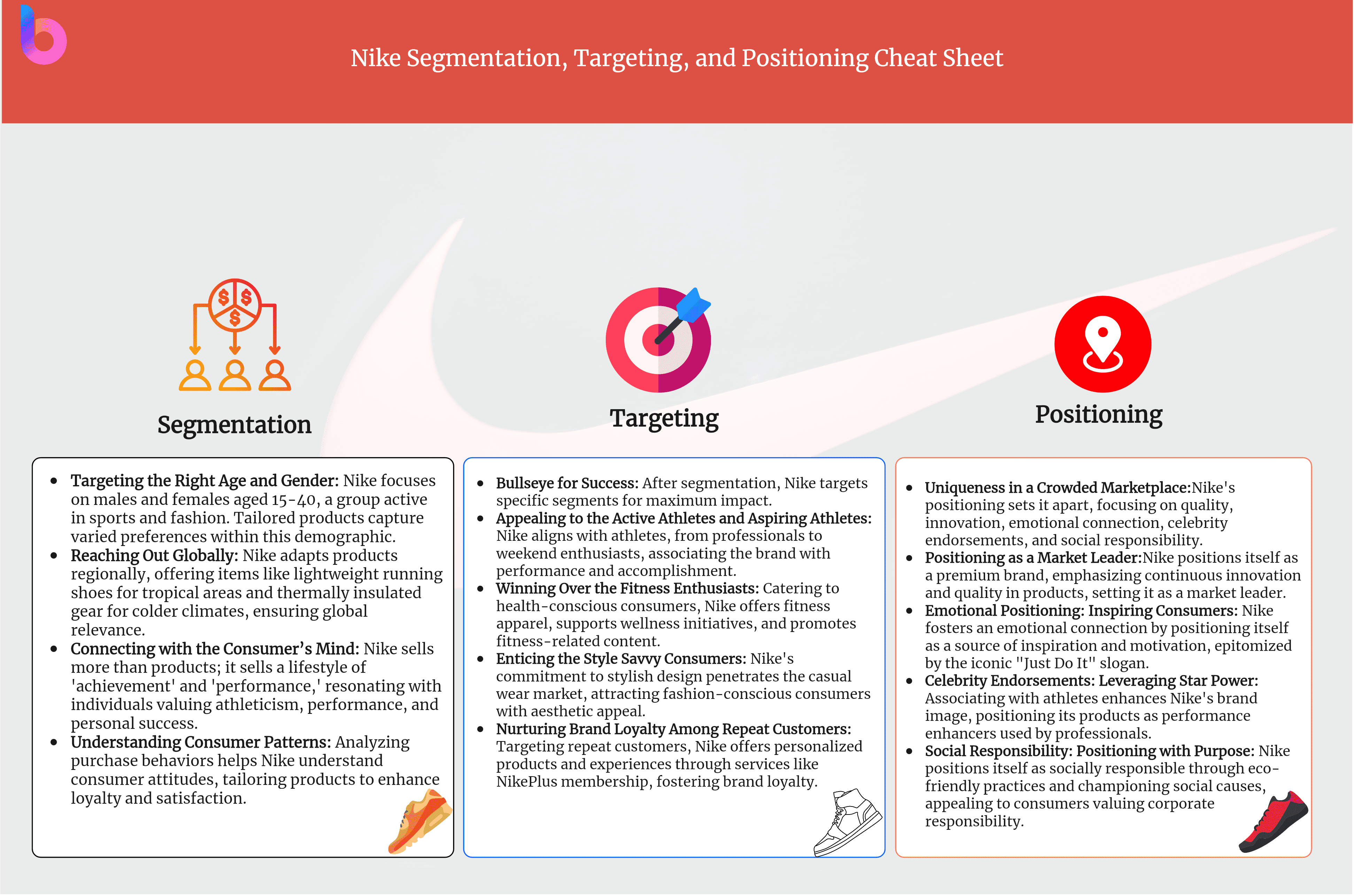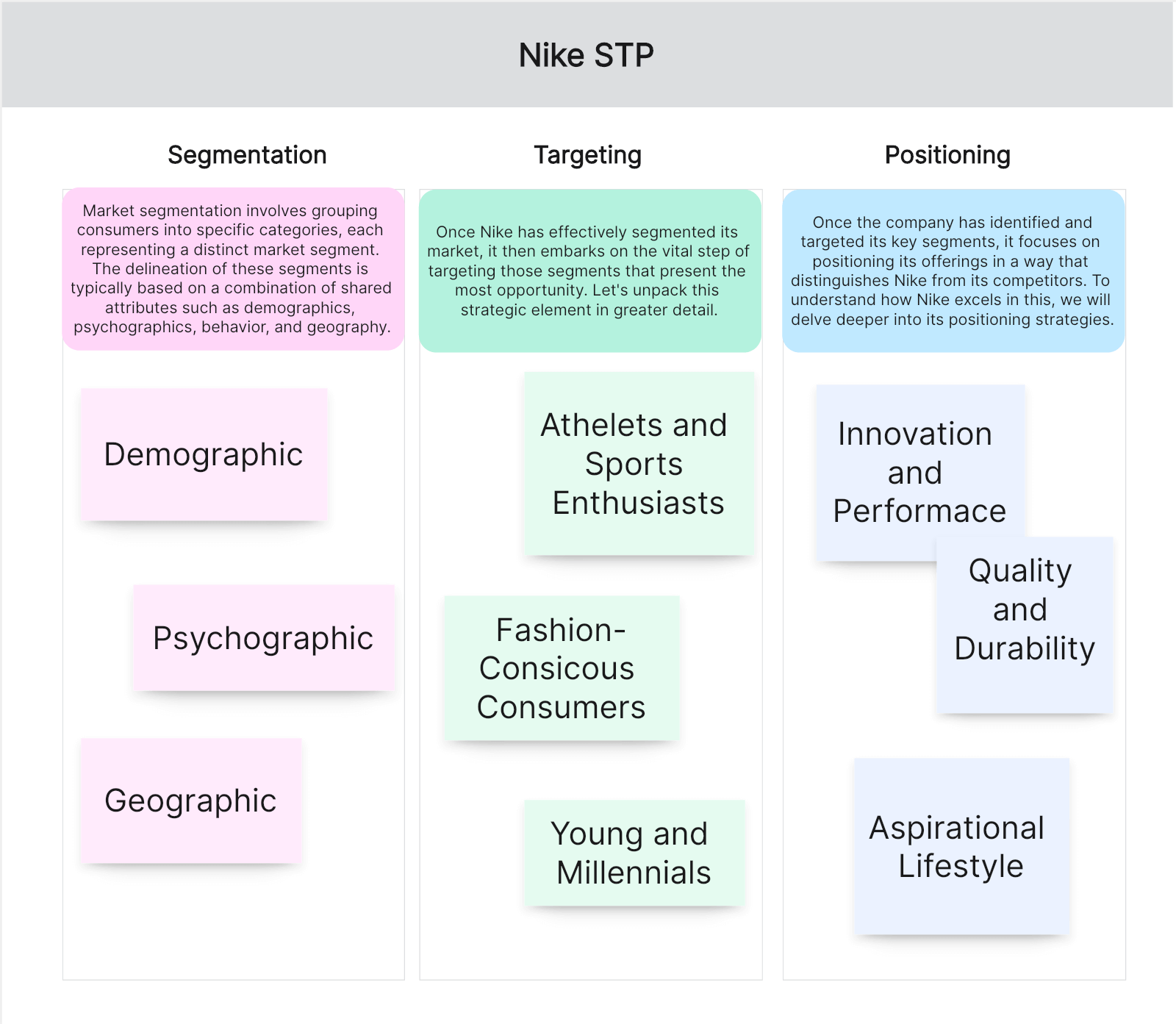Nike, Inc., the world-renowned sports apparel powerhouse, owes much of its worldwide success to well-executed segmentation, targeting, and positioning (STP) strategy of Nike. Within this article, we shall take an intensive exploration into the company's market strategy and offer an exhaustive look at how this multinational corporation utilizes these tactics to retain its place at the pinnacle of its industry.
A Mind Map of Nike’s STP Strategy: Unraveling the Intricacies
In order to gain a clearer understanding of the intertwined elements within Nike's marketing approach, we offer a detailed mind map of its STP strategy. This map graphically represents Nike’s processes of market segmentation, its targets within those segments, and how it successfully positions its vast array of products for maximum attraction to these targeted customers.

Dissecting Nike's Market Segmentation: A Game of Strategy
The first and most critical step of Nike’s three-pronged marketing approach is market segmentation. Market segmentation involves grouping consumers into specific categories, each representing a distinct market segment. The delineation of these segments is typically based on a combination of shared attributes such as demographics, psychographics, behavior, and geography. By adopting such an approach, Nike has been able to understand its customer base more deeply and cater to their unique needs with laser-like precision. Let's dissect this strategic play in more depth.
Demographics Segmentation: Targeting the Right Age and Gender
Nike's demographic segmentation primarily targets males and females aged between 15 and 40 years, ensuring a wide but specific consumer segment. The company realizes that this age group is most likely to be involved in sports, fitness and also has a propensity to follow fashion trends. Accordingly, Nike develops sports apparel and equipment suitable for different age groups, ensuring they capture as many potential customers within this category as possible.
Geographic Segmentation: Reaching Out Globally
The brand also executes geographic segmentation, tailoring its products to the specific preferences of consumers in different regions. For example, Nike creates lightweight running shoes for tropical countries while ensuring availability of thermally insulated sports gear in colder regions. By doing so, Nike maintains its relevancy across the globe.
Psychographic Segmentation: Connecting with the Consumer’s Mind
Another interesting angle to Nike’s market segmentation strategy is its focus on psychographic aspects. The company is not just selling sports equipment; it sells an attitude, a lifestyle. By marketing the idea of ‘achievement' and 'performance', Nike has been able to resonate with individuals who are driven by these values. Hence, they target segments who value athleticism, performance, and strive for personal success.
Behavioural Segmentation: Understanding Consumer Patterns
Lastly, through behavioral segmentation, Nike identifies patterns in consumers' purchase behaviors, usage, knowledge, and response to products. This segmentation helps Nike understand the consumers’ attitude towards their brand and accordingly devise products to boost customer loyalty and satisfaction.
Nike’s comprehensive approach to market segmentation demonstrates a deep understanding of its consumer base. The diverse yet specific targeting enables them to serve their customers' unique needs effectively while also offering tailored marketing messages that resonate strongly with each group. Consequently, this fine-tuned strategy is instrumental in maintaining Nike’s stronghold in the highly competitive sports apparel market.
Targeting the Segments: Bullseye for Success
Nike has effectively segmented its market. It embarks on the vital step of targeting those segments that present the most opportunity. Let's unpack this strategic element in greater detail.
Appealing to the Active Athletes and Aspiring Athletes
Nike sets its sights on the segment of athletes and those who aspire to athleticism. This target group includes individuals engaged in various levels of athletic activity - from high-performing professional athletes to those who enjoy a good game during the weekends. Through endorsements by sports celebrities and involvement in sporting events, Nike strategically aligns its brand with performance and accomplishment, thereby appealing to this segment's values and aspirations.
Winning Over the Fitness Enthusiasts
Another significant target for Nike is fitness enthusiasts. These are individuals who prioritize maintaining their health and fitness and are inclined towards regular exercise routines. Nike caters to these consumers by offering an extensive range of fitness clothing and equipment. The brand further reaches out to this segment by promoting fitness-related content and supporting health and wellness initiatives, thereby building a strong affinity within this group.
Enticing the Style Savvy Consumers
While the majority of its product offerings are functionally athletic, Nike also scores big among fashion-conscious consumers. The brand’s commitment to stylish design has allowed it to penetrate the casual wear market successfully. From classic sneakers like Nike Air Force 1 to exclusive collaborations with designers and celebrities, Nike ensures it stays on top of the fashion game. This has attracted a large segment of consumers who purchase Nike products purely for their aesthetic appeal.
Nurturing Brand Loyalty Among Repeat Customers
Nike also targets repeat customers by offering personalized products and experiences. This includes services like NikePlus membership, which provides members with exclusive products, early access to new releases, and customized workout plans. Such initiatives work to foster brand loyalty among their existing customer base.
By targeting each of these segments with tailored products and marketing initiatives, Nike effectively draws a diverse range of consumers under its brand umbrella. This not only broadens their customer base but also allows them to maintain a robust market presence across various categories - be it athletic wear, casual fashion or fitness equipment. Therefore, the 'targeting' aspect of Nike's STP strategy plays an instrumental role in its worldwide success.
Positioning the Brand: Uniqueness in a Crowded Marketplace
Positioning, the third cog in Nike's powerful STP machine, is arguably the most visible and impactful of all. Once the company has identified and targeted its key segments, it focuses on positioning its offerings in a way that distinguishes Nike from its competitors. To understand how Nike excels in brand identity building, we will delve deeper into its positioning strategies.
Quality and Innovation: Positioning as a Market Leader
Nike’s key positioning strategy has always centered on providing high-quality and innovative products. Nike positions itself as a premium brand that incorporates the latest technology and design elements into their offerings. Its continuous innovation and commitment to quality are effectively communicated to consumers through their product features and marketing campaigns.
Emotional Positioning: Inspiring Consumers
One unique aspect of Nike's positioning strategy lies in its emotional connection with consumers. The brand consistently positions itself as a source of inspiration and motivation. The renowned "Just Do It" slogan is a prime example of this approach, acting as a rallying cry for people to push their limits, fostering an emotional connection between the brand and its consumers.
Celebrity Endorsements: Leveraging Star Power
Nike also leverages celebrity endorsements as a crucial element of its positioning strategy. By associating with well-known athletes across a wide range of sports, Nike enhances its brand image and positions its products as performance enhancers used by the pros. The consumers, seeing their idols using Nike products, perceive them to be of high quality and superior performance.
Social Responsibility: Positioning with Purpose
In today’s conscientious consumer market, Nike understands the importance of ethical branding. It has made strides in positioning itself as a socially responsible brand by implementing eco-friendly production methods and championing social causes. This helps them appeal to a segment of consumers who place significant value on corporate responsibility.
Nike's success in positioning itself as a leading, inspirational, and responsible brand in the sports apparel industry is pivotal in maintaining its competitive edge. Its well-crafted positioning strategies not only make Nike products desirable to consumers but also create a powerful brand identity that resonates with its audience on multiple levels. The synthesis of these strategies ensures that Nike stands tall and distinct in an otherwise crowded marketplace.
Nike’s STP Cheat Sheet: All You Need To Know At A Glance
We further ease your understanding by distilling these insights into an accessible cheat sheet summarizing Nike's STP strategy. The concise guide aims to provide marketing professionals or business enthusiasts with a quick yet comprehensive reference point.

Key Takeaways: Learnings from a Market Maverick
In conclusion, Nike's STP strategies are an amalgamation of precise planning and astute execution which has markedly contributed to the brand's esteemed status globally. For aspiring brands and marketers seeking to emulate this model of success, Boardmix’s pre-built Market Segmentation Template and STP Analysis Template come highly recommended. They serve as excellent resources that provide you with effective frameworks that can help shape your own robust marketing strategies.

Of course, you need to develop your business model to ensure your company has more precise goals and workflow. A diagramming software is an excellent tool you can use as you map your business model. Boardmix provides a pre-built business model canvas template. The diagram is customizable, so you can edit the colors, texts, and shapes and insert images and stickers to make it your own.
Features of Creating a Business Model Canvas on Boardmix
Developing a Business Model Canvas is a strategic activity often undertaken by startups and established businesses to identify and plan out different business aspects. Boardmix online whiteboard has numerous features that make this process more intuitive, efficient, and collaborative.
1. Interactive Whiteboard Interface
Boardmix's digital whiteboard allows users to visually layout and connect various components of the Business Model Canvas, like Key Partners, Value Propositions, Customer Segments, etc. The ability to write, draw, or annotate on the board facilitates clear expression of ideas.
2. Real-time Collaboration
Boardmix’s collaboration feature enables teams to work on the same Business Model Canvas simultaneously. This real-time interaction allows for immediate feedback, brainstorming, and iteration, which can significantly enhance the canvas’s quality and relevance.
3. Drag-and-Drop Functionality
Reorganizing ideas and elements is made easy with Boardmix’s drag-and-drop functionality. This feature helps to effortlessly structure or restructure the canvas, making the modeling process flexible and adaptive to evolving business strategies.
4. Multimedia Integration
Supplement your Business Model Canvas with rich multimedia content. Integrate images, documents, or even video clips directly into the canvas to provide additional context or explanation, enhancing comprehension and engagement.
5. AI-Enhanced Brainstorming
Boardmix’s AI enhancement feature can stimulate brainstorming by suggesting related concepts based on the inputs you provide for your Business Model Canvas. This innovative feature can contribute to the development of a comprehensive and robust business model.
6. Ready-to-use Templates
Boardmix offers pre-made Business Model Canvas templates, accelerating the modeling process. These templates provide a well-structured format that can be readily filled in with business-specific details.
7. Secure Cloud Storage
With Boardmix, you never have to worry about losing your work. Your Business Model Canvas gets auto-saved and stored securely in the cloud. This means you can access your canvas from anywhere and at any time.
By utilizing these features of Boardmix Online Whiteboard, developing a comprehensive and visually engaging Business Model Canvas becomes an enjoyable and effective process.














